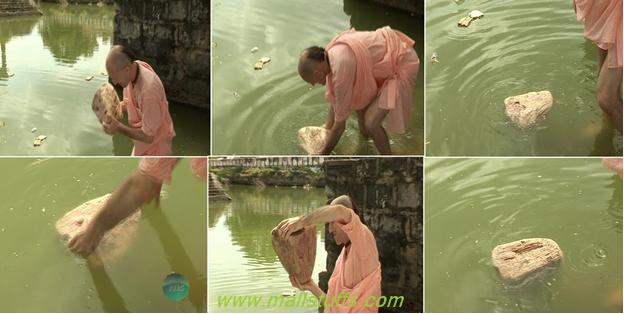MUSICAL STEPS IN AIRAVATESHWARA MANDIR; AN EXTRAORDINARY EXAMPLE OF SHILPA SHASTRA

Airavateshwara Mandir is 85 feet high vastu architecture, carved like huge vimana encased in a Lotus. Here Airavat, the four tusked white elephant of Indra prayed to Mahadev and Shiv resides here in Airavateswara form.
Entire mandir is carved with various hindu devas like Ardhnarishwar, Nagaraj, Surya, Ganga, Mohini etc and many stories of Indian history. Carving also includes types of Nrtya (dance forms like Bharat Natyam), rasa dances, gymnasium, extra ordinary musical steps, rishis, kings etc.

Musical step is one of the wonder of Chola dynasty who did that almost a thousand years ago. It is also said that temple goes back to many thousands years, Chola dynasty did many additions and maintenance time to time. To protect the musical steps, it was later grilled. The step show extra ordinary mastery of ancient indians on various musical notes and various material which could produce such musical sounds. It's one of the highest form of science in rock melting technology.
One can hear all the seven Swaras at different points at the agrr mandapa of the mandir which has an attached square porch of 7 metres (23 ft) side. It has ornately carved musical steps that go from east to west. On its east, outside the main podium, is the bali-pitham. It is unusual, in that it is produced as intricately carved balustraded steps. When one walks or steps on them, they produce a musical note. They are therefore called the #singingsteps.
HISTORY
#Darasuram is 5-6 kms from Kumbakonam in Tamil Nadu. It is said King Raja Raja II constructed this architectural and sculptural marvel temple in his name called Raja Rajishwaram (at present Airavatesvara) in 1160 in two decades. #Palaiyarai is ancient temple city and the Capital of the Cholas. King Raja Kambeera Mamannan, Raja Raja Chola II (1146 A.D. to 1172 A.D) changed his capital from Gangaikonda Cholapuram to Palaiyarai and renamed it as Raja Raja Puram (at present it is Darasuram).
There were 1000 #Thaligai (temples/mandirs) in Palaiyarai .There were 4 padai veedus (Military Camps) on all the four directions of the Capital. Thalicherippendirgal were appointed by the king to develop fine arts especially music and dance in the mandir during festival occasions. It is a world heritage monument protected by UNESCO. This temple is very different as it is highly ornate in execution to the micro level. The temple consists of a sanctum without a circumambulatory path and axial mandapas. The front mandapa known in the inscriptions as Rajagambhiran tirumandapam is unique as it was conceptualized as a chariot with wheels. The pillars of this mandapa are highly ornate. The elevation of all the units is elegant with sculptures dominating the architecture. The labeled miniature friezes extolling the events that happened to the 63 #nayanmars (Saiva saints) are noteworthy and reflect the deep roots of Saivism in this region.
MORE INFO
The ancient Sri Sthanumalayan temple in Suchindram in Kanyakumari district, the Meenakshi Sundareshwarar temple in Madurai, theAiravateshwara temple of Darasuram, and Adhinathar temple at Alwartirunagari are among the temples in Tamil Nadu that have fascinating musical stones which produce sapta swaras when tapped.
The #ShilpaShastra clearly classifies the stones and the type that ought to be used for temple architecture.
Stones, according to the Shilpa Shastra, are masculine, feminine and neuter depending on their sound and colour. #Male stone produce the tinkle of bronze bells when tapped while #female stones produce the tinkle of bass. The #neuter produces a dull sound.
Male stone is used to carve deities of Lord, while female stone is meant for making images of Goddess and neuter stone is used for the pedestal or in making ornaments as per N. Bhaskaran, a temple architect and student of Ganapathy Sthapahi, the renowned traditional architect who made the 133-feet Thiruvalluvar statue in Kanyakumari and the Valluvar Kottam.
The Shilpis displayed a remarkable skill and ingenuity in crafting “musical” pillars, which when struck at right spot produce mellifluous octaves. Though it may be difficult to identify the source of such stones, these musical pillars are of granite and charnockites. They come in different girths and volumes to produce the right octaves. Unlike the modern architecture, the ancient temples are geometrically, scientifically, and symbolically built alligned with astronomical calculations and spiritual body sciences.














